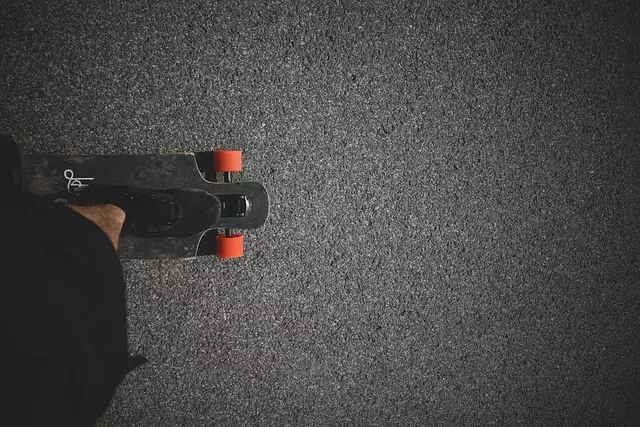For longboard beginners, selecting the right board with stability and control is crucial. Longer decks and wider wheels offer balance and a smoother ride. Focus on mastering fundamental techniques like standing, pushing, and turning to build a strong foundation. Achieve speed control through foot pushes and gentle taps for versatile riding. Learn to turn smoothly by adjusting weight distribution and stance. Regularly clean and maintain your board to preserve its condition. Prioritize safety with protective gear and basic precautions for an enjoyable longboarding experience.
“New to the world of longboarding? Discover the ultimate guide for a smooth cruising experience. From choosing your first longboard to mastering advanced techniques, this comprehensive resource caters to all levels. Learn how to select the perfect board for your needs, grasp essential techniques, and find your balance effortlessly.
We’ll explore stability tips, speed control, turning maneuvers, maintenance, and safety gear, ensuring you glide through the streets with confidence. Embrace the joy of longboarding, starting with these indispensable insights tailored for beginners.”
Choosing the Right Longboard for Your Needs as a Beginner

When just starting out with longboarding, one of the most crucial decisions is selecting the ideal board to match your skill level and desired style. As a beginner, look for a longboard designed for stability and ease of control. These boards often have longer decks for better balance and wider wheels that provide a smoother ride. Consider a drop-through or drop deck design, which places the truck closer to the ground, making it easier to push and maintain momentum.
Additionally, choose a board with a flexible yet responsive deck material like epoxy or drop-in trucks that offer a comfortable and forgiving ride. Look for a medium to slightly stiffer flex to provide stability without compromising maneuverability. Remember, your longboard should be an extension of your riding style, so take time to research and test different options until you find the perfect fit for your smooth cruising experience.
Understanding the Basics of Longboarding: Essential Techniques

For those new to the world of longboarding, understanding the fundamentals is crucial for a smooth cruising experience. A longboard for beginners should be chosen based on its design and wheel size—longer boards offer stability while smaller wheels cater to maneuverability. Beginners should start with basic techniques like standing and balancing, then progress to pushing and turning. Mastering these skills enables folks to navigate smoothly and control their speed.
Essential techniques include the push-off, where you use your foot to gain momentum, and carving turns, which involve leaning into a turn while maintaining balance. As you improve, you’ll learn to ollie (a pop of the board for small jumps) and glide through turns with fluidity. These foundational skills not only enhance the cruising experience but also open doors to more advanced longboarding tricks and maneuvers.
Finding Your Balance: Stability Tips for Smooth Cruising

For a smooth cruising experience on your longboard, finding stability is key. As a beginner, one of the first things to master is balancing your body and maintaining control while navigating different terrains. Start by choosing a board that suits your style and ability level; longer boards offer more stability but may require more skill to maneuver, while shorter boards are more agile but demand better balance.
Practice regular stances, such as the classic or goofy stance, to get comfortable with your foot placement. Engage your core muscles to keep the board steady, and use smooth, controlled movements when turning. The longboard for beginners is not just about gliding; it’s about learning to steer, stop, and maintain balance, ensuring a fun and safe cruising experience.
Mastering Speed Control: From Slow to Swift Movements

Mastering speed control on a longboard for beginners is an essential skill that allows for a smooth cruising experience. It’s all about finding the right balance between your push and the board’s response. For slow movements, focus on a controlled push with your foot, allowing the board to glide smoothly without excessive speed build-up. This technique is perfect for navigating tight turns or crossing curbs gently.
As you gain confidence, transition to swifter movements by increasing the intensity of your pushes. Practice maintaining control while accelerating, ensuring your body and the longboard stay in sync. Remember, a gentle tap of the foot can slow down the board just as effectively as a forceful stop. This versatility is what makes longboarding an engaging activity for all skill levels, enabling beginners to enjoy smooth cruising without worrying about sudden speed loss or difficult stops.
Turning and Maneuvering: Navigating Curbs and Corners Effortlessly

When it comes to enjoying a smooth cruising experience on your longboard for beginners, mastering the art of turning and maneuvering is key. Newbies often find navigating curves and corners challenging, but with practice, it becomes second nature. The secret lies in understanding how to distribute your weight and adjust your stance accordingly. By leaning into turns, you create a centripetal force that guides your board smoothly along the desired path.
Curbs can be tricky, but with the right technique, they become easily manageable. Focus on maintaining control while approaching a curb by adjusting your speed and body positioning. As you reach the curb, shift your weight forward, keeping your front truck slightly elevated to allow for a smooth transition over the bump. Practice makes perfect, so keep at it until you can navigate curbs and corners with ease, ensuring a delightful cruising experience on your longboard for beginners.
Maintenance and Care: Keeping Your Longboard in Top Shape

For a smooth cruising experience, proper maintenance and care of your longboard are essential, especially for beginners who want their board to last. Regular cleaning and conditioning keep your deck in pristine condition, enhancing grip and extending the lifespan of both the deck and wheels. Start by wiping down your board after each ride, removing any dirt or debris. Use a mild detergent and warm water to clean the deck, then rinse thoroughly and dry with a microfiber cloth.
Conditioning your longboard’s deck involves applying a protective coating that prevents wear and tear. Look for products designed specifically for longboards, and follow the manufacturer’s instructions. This step is crucial for maintaining the board’s original look and feel, ensuring a delightful cruising experience for years to come.
Safety First: Essential Gear and Precautions for New Riders

For new riders looking to enjoy a smooth cruising experience on a longboard, prioritizing safety is paramount. Before hitting the streets, ensure you’re equipped with essential gear such as a properly fitted helmet, knee and elbow pads, and protective clothing. These items are not just recommendations; they’re your first line of defense in mitigating potential risks associated with learning to longboard.
In addition to the right gear, understanding and practicing basic safety precautions is crucial. Be mindful of your surroundings at all times, especially in areas with heavy traffic or complex terrain. Wear visible clothing, use hand signals when turning, and maintain control of your board to avoid unexpected obstacles. Remember, taking the time to learn and follow these simple measures will significantly enhance your overall cruising experience on your longboard for beginners.
